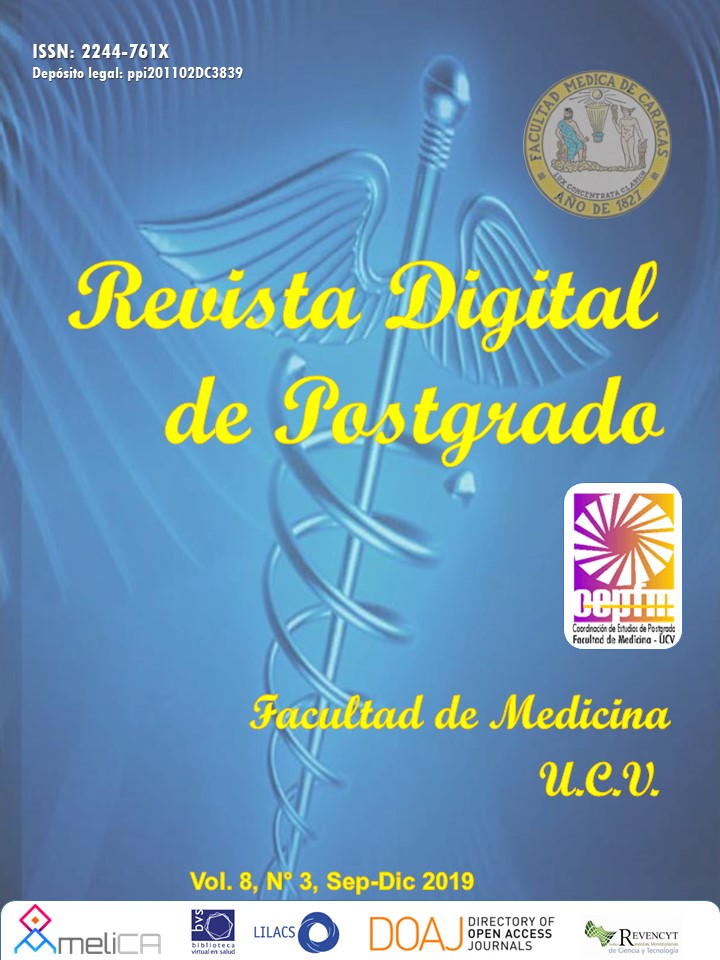Necrotizing pneumonia in a pediatric patient
Keywords:
Preschool, Respiratory distress, Community-acquired pneumonia, Necrotizing pneumonia, Antibiotic therapy.Abstract
Pneumonia is the cause of death of approximately 4 million children a year around the world, the vast majority in developingcountries. In the first year of life, the incidence is 15-20 cases/1,000 children/year. From 1 to 5 years it reaches 30-40 cases and,again, it goes down in those older than 5 years to 10-20 cases/1,000 children/year. It is an acute infection of the lower respiratorytract acquired in the community with a duration of less than or equal to 14 days, which causes cough and / or respiratory distressand with radiological evidence of acute pulmonary infiltrate. Streptococcus pneumoniae is the main bacterial agent. e case ofa 2-year-old male preschooler is presented. He begins his current illness with anterior hyaline rhinorrhea, hyperthermia notquantified, dry cough. It is evaluated by a physician and performs paraclinics that report leukocytosis, neutrophilia and reactivethrombocytosis, diagnose a lower respiratory infection and indicate antimicrobial treatment by oral route, which does not showimprovement. Aerwards, respiratory distress is associated, consultation with the health center where they enter and indicate medical treatment during 48 hours without clinical improvement, refer to the University Hospital of Caracas in regular generalconditions. Chest CT shows suggestive images of bilateral necrotizing pneumonia, double antibiotic therapy is indicated for11 days to cover resistant Streptococcus pneumoniae and / or community-acquired methicillin-resistant Staphylococcus Aureus,producer of Panton - Valentine leukocidin. With satisfactory clinical evolution, he withdrew, with oral antibiotic therapy for 21days and control by Pneumopediatrics.Downloads
References
Crespo V, Bruce B, Herrera C de J, Martínez R, Mendoza C, Ríos M, et al. Diagnóstico y Tratamiento de la
Neumonía Adquirida en la comunidad en las/los Pacientes de 3 meses a 18 Años en el Primero y segundo nivel
de Atención México: Instituto Mexicano del Seguro Social; 1 de diciembre de 2015; 1-67.
Sanz L, Chiné M. Neumonía y neumonía recurrente. Pediatr Integral. 2016; XX (1): 38-50. [acceso 30 de
septiembre de 2018]. Disponible en: https://www.pediatriaintegral.es/wp-content/uploads/2016/xx01/04/
nl-038-050_LidiaSanz.pdf
Martín A, Moreno D, Alfayate S, Couceiro J, García M, Korta J, et al. Etiología y diagnóstico de la neumonía
adquirida en la comunidad y sus formas complicadas. An Pediatr (Barc). 2012;76(3):162.e1-162.e18
Méndez A, García M, Baquero F, Del Castillo F. Neumonía adquirida en la comunidad. Protocolos diagnósticoterapéuticos
de la AEP: Infectologia pediátrica. Asociación Española de Pediatría; 2011
Kassisse E, Gil J, Planchet J. Neumonía secundaria a Staphylococcus aureus resistente a la meticilina. Neumol Pediatr.
; 8 (1): 17-21.
Rupérez E, Herranz M, Bernaola E. neumonía en el paciente pediátrico. [Libro electrónico de Temas de
Urgencia]. 2008 enero. [Acceso 12 de mayo de 2018]. Disponible en: https://www.cfnavarra.es/salud/
PUBLICACIONES/
Andrés A, Asensio O, Pérez G. Complicaciones de la neumonía adquirida en la comunidad: derrame pleural,
neumonía necrotizante, absceso pulmonar y pioneumotórax. Protoc diagn ter pediatr. 2017; 1: 127-146.
Machado K, Kouyoumdjian G, Algorta G, Pírez C. Neumonía necrotizante en niños hospitalizados en el Hospital
Pediátrico Centro Hospitalario Pereira Rossell en el año 2010. Arch Pediatr Urug 2013; 84(2): 101-110.
Pericas J. Neumonía y neumonía recurrente. Pediat integ. 2012 [Revisado en volumen XVI/número 1/enero
/curso V]. Acceso 30 de septiembre de 2018. Disponible en: https://www.pediatriaintegral.es/numerosanteriores/
publicacion-2012-01/neumonia-y-neumonia-recurrente/
Messinger A, Kupfer O, Hurst A, Parker S. Management of Pediatric Community-acquired Bacterial Pneumonia.
Pediatr Rev. 2017; 38 (9): 394-409.
How to Cite
Issue
Section
License
Usted es libre de:
- Compartir — copiar y redistribuir el material en cualquier medio o formato
- Adaptar — remezclar, transformar y construir a partir del material
- para cualquier propósito, incluso comercialmente.
Bajo los siguientes términos:
-
Atribución — Usted debe dar crédito de manera adecuada, brindar un enlace a la licencia, e indicar si se han realizado cambios. Puede hacerlo en cualquier forma razonable, pero no de forma tal que sugiera que usted o su uso tienen el apoyo de la licenciante.
- No hay restricciones adicionales — No puede aplicar términos legales ni medidas tecnológicas que restrinjan legalmente a otras a hacer cualquier uso permitido por la licencia.











